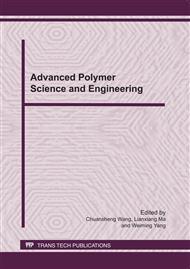[1]
D. Exerowa and P. M. Kruglyakov, Foam and Foam Films: Theory, Experiments, Application, Elsevier (1998).
Google Scholar
[2]
W. R. Rossen, Foams in enhanced oil recovery". In: R. K. Prud, homme and S. Khan (Editors), Foams: Theory, Measurements and Applications. Marcel Dekker (1996).
DOI: 10.1201/9780203755709-11
Google Scholar
[3]
L. W. Holm, The Mechanism of Gas and Liquid Flow through Porous Media in the Presence of Foam, Society of Petroleum Engineers Journal, Vol. 8, No. 4 (1968), p.359.
DOI: 10.2118/1848-pa
Google Scholar
[4]
J. Ali, R. W. Burley and C. W. Nutt, Foam Enhanced Oil-Recovery from Sand Packs, Chemical Engineering Research and Design, Vol. 63, No. 3(1985), p.101.
Google Scholar
[5]
W. Lake, Enhanced Oil Recovery, Prentice Hall (1989).
Google Scholar
[6]
T. W. Patzek, Field Application of Foam for Mobility Improvement and Profile Control, SPE Reservoir Engineering, Vol. 11 (1996), p.79.
DOI: 10.2118/29612-pa
Google Scholar
[7]
S. A. Zhdanov, A. V. Amiyan, L. M. Surguchev, L. M. Castanier and J. E. Hanssen, Application of Foam for Gas and Water Shut-off: Review of Field Experience, SPE 36914 in European Petroleum Conference held in Milan, Italy (1996).
DOI: 10.2118/36914-ms
Google Scholar
[8]
A. T. Turta and A. K. Signhal, Field Foam Applications in Enhanced Oil Recovery Projects: Screening and Design Aspect, SPE 48895 in SPE International Oil and Gas Conference and Exhibition in China (1998).
DOI: 10.2118/48895-ms
Google Scholar
[9]
L.W. Holm, V. A. Josendal, Mechanism of Oil Displacement by Carbon Dioxide, Journal of Petroleum Technology, Vol. 26 No 12 (1974), p.1427.
DOI: 10.2118/4736-pa
Google Scholar
[10]
D.H. smith, Promise and Problems of Miscible-Flood Enhanced Oil Recovery: The Need for Surfactant-Based Sweep and Mobility Control, ACS Symposium Series 373 (1988).
DOI: 10.1021/bk-1988-0373.ch001
Google Scholar
[11]
F.I. Jr. Stalkup, Miscible Displacement, Monograph No. 8, Society of Petroleum Engineers of AIME, New York (1983).
Google Scholar
[12]
F.P. Bretherton , The motion of Long bubbles in Tubes, J. Fluid Mech., vol. 10 (1961), p.166.
Google Scholar
[13]
G.J. Hirasaki and J.B. Lawson: Mechanisms of foam flow in porous media: Apparent viscosity in smooth capillaries, SPE J., vol. 25, No. 2 (1985), p.176.
DOI: 10.2118/12129-pa
Google Scholar
[14]
Q. Xu and W. R. Rossen, Effective Viscosity of Foam in Periodically Constricted Tubes, Colloids and Surfaces A, Vol. 216 (2003), p.175.
DOI: 10.1016/s0927-7757(02)00547-2
Google Scholar
[15]
Q.P. Nguyen, P. K. Currie and P. L. J. Zitha: Motion of foam films in diverging-converging channels, Journal of Colloid and Interface Science, Vol. 271 (2004), p.473.
DOI: 10.1016/j.jcis.2003.12.010
Google Scholar
[16]
Y. Li, Z. M. Li and R. Y. Lin, Temperature Distribution of Bingham Fluid in Annular Duct", Journal of Xi, An Technological University, Vol. 3 (2007), p.219. (in Chinese).
Google Scholar
[17]
Z. M. Li, X. H. Tang and Y. Wang, Study on Rheology Property and Stability of DY-1 High Temperature Foaming Agent, Drilling and Production Technology, Vol. 28 (2005), p.91. (in Chinese).
Google Scholar
[18]
Z. M. Li, Y. Wang and Q. Zhang, The Law of Velocity Distribution of Bingham Fluid's Flowing in the Encircle Pipe, ACTA Petrol Ei Sinica, Vol. 23 (2002), p.87. (in Chinese).
Google Scholar
[19]
Z. M. Li, S. Y. Li, Z. H. Shang and Y. Li, Numerical Simulation of Foam Fluids Laminar Jet Flow, Drilling Fluid & Completion Fluid, Vol. 24 (2007), p.58. (in Chinese).
Google Scholar
[20]
Z. M. Li, M. S. Sun and Y. B. Wu, Laminar Flow of Foam Fracturing Fluid in Fractures, Journal of Guangxi University (Nat. Sci. Ed. ), Vol. 31 (2006): 212. (in Chinese).
Google Scholar
[21]
D.X. Du, Y.G. Li, S.J. Sun, Experimental Study on Pseudo-plastic Behavior for Film Foam Flow in a Vertical Tube, submitted to 2010 Advance Polymer Process International Forum, Qingdao, China (2010).
Google Scholar
[22]
Q.P. Nguyen, Dynamics of foam in porous media, Ph.D. dissertation, Delft University of Technology (2004).
Google Scholar
[23]
T.G. Monger, Measurement and prediction of swelling factors and bubble points for paraffinic crude oils in the presence of CO2 and contaminant gases, Industrial & Engineering Chemistry Research, vol. 26, No. 6 (1987), p.1147.
DOI: 10.1021/ie00066a015
Google Scholar
[24]
F.T.H. Chung, R.A. Jones, H.T. Nguyen, Measurement and Correlations of the Physical Properties of CO2/Heavy-Crude-Oil Mixtures, SPE Reservoir Engineering, vol. 3, No. 3 (1988), p.822.
DOI: 10.2118/15080-pa
Google Scholar
[25]
T.A. Ngyuen, S.M. Farouq-Ali, Effect of Nitrogen on the solubility and diffusivity of Carbon Dioxide into oil and oil Recovery by the immiscible WAG process, Journal of Canadian Petroleum Technology, vol. 37, No. 2 (1998), p.24.
DOI: 10.2118/98-02-02
Google Scholar
[26]
D.X. Du, P.L.J. Zitha, M. Uijttenhout, Carbon Dioxide Foam Rheology in Porous Media: a CT Scan Study, SPE J., vol. 12, No. 2 (2007), p.245.
DOI: 10.2118/97552-pa
Google Scholar
[27]
D. X. Du, A. Naderi Beni, R. Farajzadeh and P. L. J. Zitha, Effect of Water Solubility on Carbon Dioxide Foam Flow in Porous Media: an X-Ray Computed Tomography Study, Industrial & Engineering Chemistry Research, Vol. 47, No. (2008), p.6298.
DOI: 10.1021/ie701688j
Google Scholar


